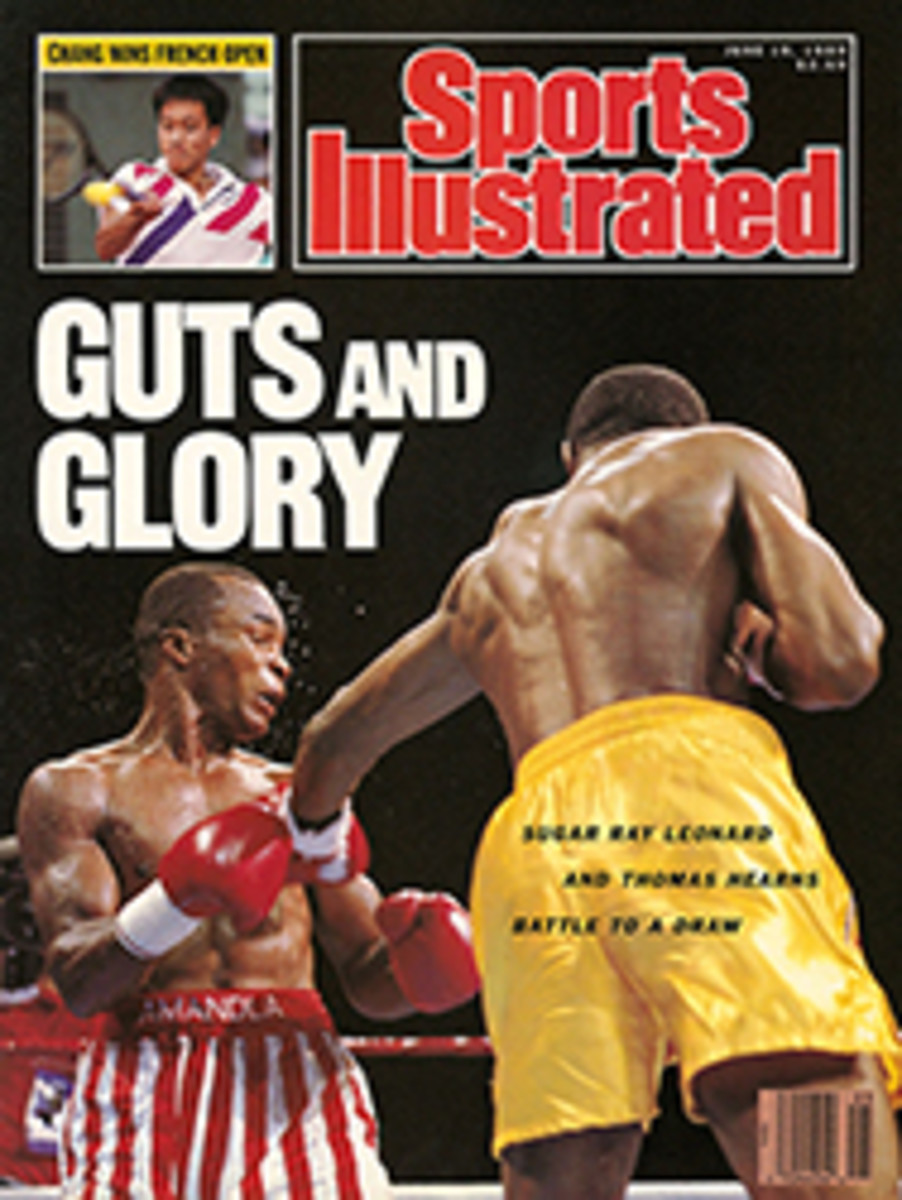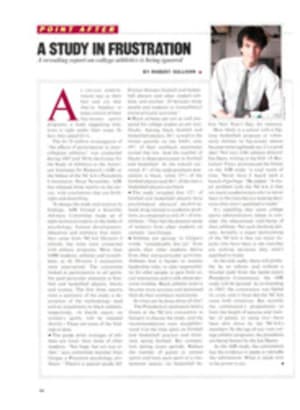
INSIDE: BASEBALL
PARKING IT
Consider the difference between Red Sox outfielder Mike Greenwell, who had 22 homers and 119 RBIs in '88, and Cardinals outfielder Vince Coleman, who had only three homers and 38 RBIs but led the NL in steals with 81. Then look at the parks they play in: Fenway, which is a home run hitter's paradise, and Busch Stadium, where only 68 homers were hit last year.
To measure the differences between the American and National leagues, you have to start with the ballparks. They determine not only how the game is played in each league, but also how each team puts together its lineup. "Today you have to have totally different players than you used to in the National League," says St. Louis manager Whitey Herzog. "Quickness is a must, because bad defense will kill you on the turf in the big parks."
The fact that the National League is loaded with cavernous parks, such as Busch, Dodger Stadium and the Astrodome, and the American League with intimate settings like Fenway, Tiger Stadium and the Metrodome, has a profound impact on how teams from each league use the draft, according to Cub scouting director Dick Balderson. "You can take a chance on a guy just for his bat in the American League, and if you have to, DH him," he says. "Because there is less turf and there are more small outfields, you can have a leftfielder who hits homers but is a defensive liability. The guy that comes to mind is [Rangers outfielder] Pete Incaviglia. Why Montreal originally drafted him, I don't know, but he is fine in the American League."
Two exceptions are the Royals and—now that they are in SkyDome—the Blue Jays. Instead of going after sluggers in the June draft, Toronto selected a bunch of speedsters to take advantage of SkyDome's spacious proportions. Says Toronto scout Tim Wilken, "Our change in ballparks probably eliminated a lot of kids we would have liked in the past because Exhibition Stadium was such a home run hitter's park."
By contrast, Boston's first two picks were power hitters: Sarasota (Fla.) High outfielder Greg Blosser and Seton Hall first baseman Maurice Vaughn. "A National League team wouldn't choose two pure bats in the first round the way Boston did," says one scouting director. "But in Fenway there isn't much ground to cover—there isn't any in foul territory. You've got to have thunder."
SPENDING SPREE
Another trend that became apparent in this year's draft is the increase in what teams are spending on signing bonuses. It has been mushrooming almost as fast as major league salaries in recent years. In the early 1980s a low first-round pick would have had a hard time getting a six-figure signing bonus. But now clubs like the Braves, Expos, Yankees, Dodgers and Blue Jays are willing to shell out big bucks to sign high school players.
For example, three years ago the Braves spent $400,000 signing players; in '88 the ante rose to $1.4 million. "Developing one's own talent is the name of the game if you don't want to be held hostage by free agents," says Atlanta general manager Bobby Cox. "You have to take chances, but a hundred grand at this end can be a lot less of a gamble than a few million at the other end."
The Blue Jays will probably have to lay out more than $1.2 million to sign their six top draftees this year, because all of them, except for the first pick, Fresno State shortstop Eddie Zosky, have conflicting obligations. "[Toronto general manager] Pat Gillick loves those challenges," says a scouting director for another team. "After all, he's the man who signed Danny Ainge, Jay Schroeder, Bobby Bourne and Clark Gillies." Ainge is currently a member of the Sacramento Kings, and Schroeder is with the Los Angeles Raiders. Bourne and Gillies have both retired from the NHL.
Toronto's second pick this year was Beverly Hills High outfielder Michael Moore, whose father is a real estate tycoon and whose uncle is broadcaster Ahmad Rashad. "He's the only kid I ever saw that arrived at games in a Rolls-Royce," says Boston scout Joe Stephenson. Indeed, you can see the Rolls in the Major League Scouting Bureau's videotape on Moore. Toronto's problem is not only that Moore's family is loaded but also that he plans to play wide receiver for UCLA this year. As a result, he told baseball scouts it would take an $800,000 package to get him to sign.
Another Toronto gamble is first baseman-pitcher John Olerud, who announced before the draft that he will return to Washington State next year instead of turning pro. Gillick picked him in the third round anyway and is hoping he can change Olerud's mind with a substantial offer. Gillick's three other risky picks are St. Lawrence (Ill.) High outfielder Brent Bowers, who is still considering three colleges; Scotch Plains (N.J.) High centerfielder Jeff Hammonds, who currently plans to go to Stanford; and Eisenhower (Wash.) High pitcher Pat Leahy, who has signed with Notre Dame.
Here are some other interesting draft developments:
•The A's picked third baseman/quarterback Rodney Peete again—this time in the 13th round—but it's uncertain whether they will be any more successful signing him this year than they were last year, when he turned down a $100,000 offer.
•The biggest surprise of the first round was the Rangers' selection of Texas Tech outfielder Donald Harris as the fifth pick overall. Harris was a second-team All-Southwest Conference safety as a sophomore last season and is expected to be an NFL first-rounder in 1991.
•The Dodgers made two selections based on bloodlines. With their third pick, they took Florida reliever Jamie McAndrew, son of former Met Jim. And in the second round they took Petal (Miss.) High outfielder Billy Lott Jr., son of former AFL running back Billy Sr.
•L.A. catcher Rick Dempsey's son, John, a catcher-third baseman at Crespi (Calif.) High, was picked in the 10th round by the Cardinals. Will they become the next father-and-son combo in the majors?
ALL THAT JAZZ
Are this year's baseballs juiced up? Herzog seems to think so. "We unveiled the new [National League president] Bill White-autographed balls for the first time on the last home stand, and balls were flying out of Busch Stadium," he said last week. "The Cubs hit six homers in one game. The balls are harder, and a lot of the seams are so low, pitchers can't grip them." Last year, by contrast, the Cubs hit only six homers in St. Louis.... Observers scoffed when San Francisco manager Roger Craig made Scott Garrelts a starter this season because he has had serious control problems as a reliever. But at week's end he was 5-1, with a 2.43 ERA. "When Scott was a reliever, he tried to throw too hard," says Craig. "That's why he was so wild. As a starter, he conserves his stuff better, and it turns out he's better throwing 92 than trying to throw 95." ...As the College World Series (page 71) progressed, Oriole officials became increasingly concerned that LSU coach Skip Bertman might have blown out the arm of their top draft pick, righthander Ben McDonald. Three nights after McDonald threw 138 pitches in a losing outing, Bertman warmed him up three times for a relief appearance. McDonald ended up losing two games and allowing 15 earned runs in 12 innings of postseason play. The O's plan to give McDonald three weeks off after he signs, then keep him in a five-man rotation in Double A to rest his arm.... The first indication that there may be problems between Yankee manager Dallas Green and owner George Steinbrenner came last week when Green told broadcaster Bill Campbell of Philadelphia's WIP, "I may be doing my radio show with you sooner than you thought. You never know what will happen with this guy [Steinbrenner].
ILLUSTRATION
BETWEEN THE LINES
BUBBLE UP
On June 7 Phillie leftfielder John Kruk caught a fly ball for the second out of the inning, but he thought it was the third. And as he put his head down and started running in, Pittsburgh's Bobby Bonilla tagged up and scored all the way from second. "From now on, we're going to give Kruk three sticks of bubble gum," says Phillie coach Larry Bowa. "After each out, he's going to put one in his mouth, and when he's out of gum, he'll know it's time to come in."
A STUDENT-ATHLETE'S DREAM
If everything goes right for Steve Bast, a lefthander for the Triple A Pawtucket Red Sox, he could pull off an interesting double: playing major league baseball while pursuing a career in medicine. Bast, who is currently one of Boston's top pitching prospects, was a premed honor student at USC and is in the process of applying to Harvard Medical School, which is within walking distance of Fenway Park, and several other institutions. No matter where he goes to school, Bast will bring a lot of firsthand experience to his medical studies. While in college, he worked as an exercise physiologist at the National Athletic Health Institute in Culver City, Calif., and in 1987 he had his arm reconstructed a la Tommy John by famed surgeon Dr. Frank Jobe.
DOUBLE DUTY
During a June 6 game in Toronto, Brewers manager Tom Trebelhorn moved righthanded reliever Chuck Crim to first base, and in order to force switch-hitting Nelson Liriano to bat righthanded, brought in lefty Tony Fossas. After Liriano singled, Trebelhorn moved Crim back to the mound to get the final two outs and save the 6-4 win. Said Brewers starter Chris Bosio, "Crim relieved himself on the mound in front of 40,000 people in the SkyDome."
UNDER THE LIMIT
The A's radar gun clocked Cleveland righthander Tom Candiotti's curveball at 58 mph on June 3. "It's tough to hit a guy who throws that slowly," said Oakland hitting coach Merv Rettenmund. "We throw harder than that in batting practice." The remark didn't bother Candiotti, a knuckle-bailer who was 7-3 at week's end. "My slow curve operates below the hitting speed limit," he says with a shrug.
MISCELLANEOUS
•When Phillie second baseman Steve Jeltz and Ranger outfielder Ruben Sierra each homered from both sides of the plate on June 8, it was the first time that two players had accomplished that feat on the same day.
•The Orioles picked up 12 unearned runs in their 16-3 defeat of the Yankees on June 5. Before that game, Baltimore's defense had allowed only six unearned runs for the whole season.
•Shortstop Kurt Stillwell, who was hitting .278 through Sunday, has gone 21 for 50 (.420) in domes since he started playing for the Royals in '88. That's not surprising. In his last season with the Reds—1987—he had more hits (13) in the Astrodome than any visiting player.
•At week's end Dodger righthander Mike Morgan was leading the National League with a 1.47 ERA, but his record was only 4-4 because L.A. hasn't scored more than three runs in any of his 10 starts.
•Weather warning: Through Sunday the Orioles led the majors in rainouts, with seven. That means they will have to play 40 games in 39 days from July 31 to Sept. 7.

